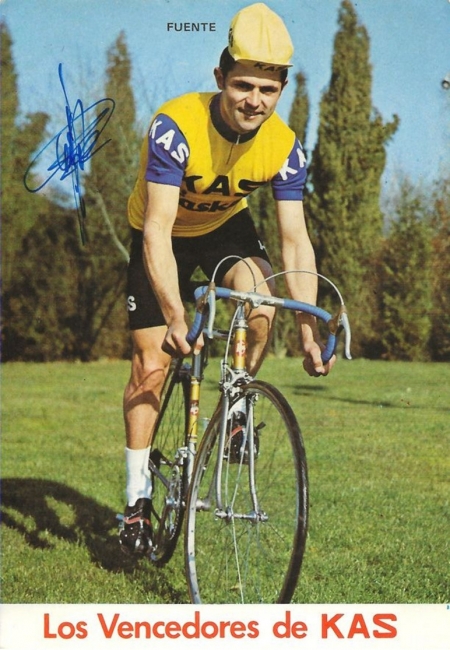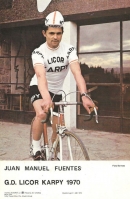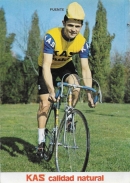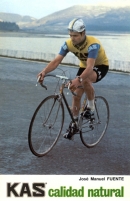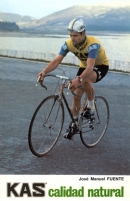José Manuel Fuente was in de eerste helft van de jaren zeventig een van de beste klimmers uit het peloton. Hij won 14 bergetappes in de drie grote rondes en eindigde ook in zowel de Tour, de Giro en de Vuelta minstens een keer op het podium. Op medisch advies moest Fuente al op relatieve jonge leeftijd stoppen. Hij was ook nog korte tijd aktief als ploegleider.
Theo Vaessen
José Manuel Fuente was Professional between 1970 and 1976, altough in the last two years he hadn´t had any significant results, since he retired at 1975 Vuelta, because of a strange disease that forced him to retire from racing in 1976, only with 31 years old.
This disease, supposingly from kidney, forced him to do hemodialisis till his death, in 1996.
Tarangu, an asturian, had is first significant result when won Vuelta a Tarragona 1969. Next year, he became professional with the small Spanish team Licores Karpy, of Eduardo Castello, that had in his rangs riders such Gonzalo Aja (5th at 1974 Tour), Antonio Menendez (won a stage in 1976 Giro) and Jose Maria Santisteban (that sadly died after a fall in Giro 1976). All of these were riders that had significant international results. Altough the team was small, Fuente had done a good Vuelta, finishing 16th and 1st of neo-pros. This race, his 5th place at Vuelta as Asturias (winner of the points jersey), and his win at last stage of Vuelta a Catalunya, let him to be engaged by KAS, the best spanish team and one of the best teams in the world.
KAS put him as leader for 1971 Vuelta, conscious of his potential, but the race was a disillusion. Fuente finished only in 54th position and never appeared along the race. It was a bad Vuelta for KAS and other Spaniards, won by Bracke.
At the Giro KAS was under pressure after their bad results. The team leader was the experienced Uribezubia. But it was in this Giro that started the Tarangu legend. Without Merckx, Fuente, although he finished only 39th, won a difficult stage, the Pian de Falco top finish, alone. After this day, Fuente started collecting mountain points, winning the green jersey at the end of the race. KAS had a good race, Lopez Carril won the 5th stage, finishing at Gran Sasso d’Italia and Perurena won 6th stage.
Altough he had raced already two big stage races, KAS decided to put him in the Tour de France. With only 25 years old, he raced the three big races. The Tour had begun very badly. At Orcieres Merlette, arrived out of time with more 68 riders, after the genial win of Ocaña. The same happened the following day. Re – classified because there were too many riders eliminated, Fuente showed that he wasn´t so tired as others think, winning the next mountain stage at Luchon, after a solitary escape. The 1st day of glory for Fuente was an horrible day for Ocaña, that had is famous falling the Aspin descent. Next day, Fuente escape again and arrive alone at Superbagnères. In the final classification, arrived only 72nd, more than two hours after Merckx.
In those time, Ocaña was the idol, by the French fans (he lived many years at Mont-de-Marsan) and by the Spanish fans, that searched for an heir of Bahamontes’ glory. Fuente, for the fans, was the heir of Julio Jimenez; an excellent climber, but without regularity to win a GT.
When Vuelta 1972 started, without Ocaña, the favourites were KAS riders Lasa and Perurena, that were doing a good season. Both wore yellow jersey and Perurena seems a solid leader before the mountain stage to El Formigal. But it was this stage that put Fuente definetively as a legend. 2’21’’ behind Perurena, Fuente attacked at the first kms of the stage, with Pepe Grande, from the rival team La Casera, of Tamames. For many, Fuente was working for the team. But, at Monrepós, Fuente leaves Grande and escapes alone. At the top, Fuente had 1’30’’ of advantage to Grande and 5’46’’ to the first group. But Tarangu , not only hadn´t lost rhythm, but had broken off the peloton. When he arrived, he was 6’37’’ before Menendez and almost 9’ before Tamames, Lasa and Perurena. Fuente had wrote on of the most beautiful pages of the Spanish cycling history. His advantage was so big that Fuente had the Vuelta won, 5 days before the end of the race. Altough the attacks of Tamames, Fuente won the Vuelta and GPM.
At the Giro, Fuente showed Merckx that he wasn´t a rival that the Cannibal can underestimate. At Blockhaus, 1st top finish stage, Fuente won, and becames maglia rosa. He won 2’ to Merckx. But, three days later at Calabria mountains, Merckx attacked with Pettersson and wore the maglia rosa, leaving Fuente and others 4’31’’ behind. Fuente won again in the Stelvio, won the GPM and finished 2nd at final classification. When the year finished, Fuente (that hadn´t raced at Tour de France), showed why he was on of the best riders in the world.
In 1973, Fuente will race Giro and Tour. At Giro, Merckx started better and won the 1st mountain stage. Later, decided the Giro at Monte Carpegna. Fuente was in bad condition, but won the last mountain stage, escaping alone at the 1st uphill. Won the stage, 1’00 ahead of an young Moser and 2’50’’ ahead of Merckx. Finished 8th and won his 3rd consecutive GPM. Before the Tour, Fuente engaged in Tour de Suisse, to prepare the franch race. Fuente used the mountain stages to win the race (won Grachen and Meiringen stages, and finished 2nd at uphill timetrial at Sattelegg). At Meiringen, repeated Formigal legend, arriving with 5’22’’ ahead of the Italians Coniati and Giuliani.
When the Tour begun, it was no doubt that Fuente was the best climber of the world and the question was if Ocaña would have capacity or not to beat him. But Ocaña hadn´t waited by the Alps to show that he was the best without Merckx (that raced Giro and Vuelta in 73). With his helpers Catieau, Mortensen, Vasseur and Schleck, attacked at Roubaix cobblestones (at Querenaing section). Fuente arrived 7’17’’ behind. At Les Orres. 1st mountain stage, Ocaña showed that he was simply the best in that race. Fuente attacked first, at Télégraphe. In the downhill the front group was composed by Ocaña, Fuente, Thévenet, Zoetemelk, Ovion, López Carril and Pedro Torres. At Galibier, only Ocaña and Fuente stayed at the front. At Serre Chevallier, they had 1’ of advantage behind Thévenet, López Carril and M.Martinez and 5’30’’ behind Van Impe and Poulidor. At Izoard, the Spanish duo had 4’50’’ to Thévenet and Martinez and 9’20’’ to López Carril….
Fuente stayed with Ocaña till Les Orres, when he suffered a puncture, arriving 58’’ after the leader. M.Martinez arrived 3rd,7’ later, with Thévenet. 5th was Périn, 12’33’’ after Ocaña and Zoetemelk, Van Impe ans López Carril 20’24’’ later. The Tour was sentenced. Ocaña had 9’ to the second, Fuente and more than 10’ to Thévenet. Périn was more than 19’ behind, in 4th. At the Pyrenees, Thévenet gained half a minute to Fuente, taking the 2nd place at Bordeaux TT. Fuente arrived 3rd,and, with Induraín, is the only one that arrived at the podium in the three GT, and only in two years.
In 1974, Fuente decided to return to the Vuelta. With a luxurious riders list, with Ocaña, Thévenet, Agostinho, etc (the 1st time the podium of the last Tour had been present at the Vuelta); it promises a good race. Thévenet attcacked on the first day and took the lead, but Perurena took it from him at 4th stages, thanks to bonifications. Fuente won the 1st mountain stage, at Los Angeles de San Rafael, but Perurena remained leader. Next day, a small hillclimb TT was won by Delisle, Fuente was second and took leader’s jersey. At Naranco, Fuente won again, alone, after escaping from a little group, composed by Agostinho and his teammate Lasa. The relationship between Lasa and Fuente never was the same. Although the race seems decided, the next day, Ocaña, delayed by mechanical problems, attacked. Fuente counter-attacks like Pantani in Oropa and arrives with Agostinho at the finish line.
But, the day before the finish Fuente falls at the streets of Eibar. With blood on the face, arrives, loosing 41’’ to Lasa and Tamames. The last and traditional crono, in Anoeta, seems very emotional. Can Fuente, bad TT and touched by the fall resist to: Lasa? Ocaña? Agostinho? He had a good advantage: 1’32’’ to Lasa, 2’35’’ to Agostinho…
Agostinho surprises, giving more than 1’ to Ocaña and 2’ to Lasa. Suspense. But Fuente arrives 2’14’’ later, winning his 2nd Vuelta by 11’’. He shares the record with Deloor and Berrendero.
At 28 years old, he was mature and is a secure value at long stage races.
Again, Fuente decided to race the Giro. For the last time, he will race against Merckx. At 3rd stage, with some mountains, Fuente arrived solo, 42’’ before Merckx. Two years later, he was maglia rosa again. At 9th stage, with one climb, Tarangu repeats the victory, 1’ ahead of Merckx and almost 2’ ahead of the 1st group.
Two days later, 3rd mountain stage and 3rd Fuente victory. Again, Merckx is 2nd, this time 41’’ later. Two victories alone with maglia rosa convainced Italian press to the power of Tarangu at rough Italian climbs. But Merckx didn´t want to loose. At the 1st TT, gains 3’ to Fuente, that remains leader, but with a small margin. The next day, he looses his jersey, in a flat stage. Fuente was caught with a little problem, Merckx attacked and Fuente replied, withot eating. Obviously, hadn´t enough rythm and arrived 6’ after the peloton, saying goodbye to maglia rosa. Forever…
But Tarangu saved his honor, winning two more stages, the 1st at Mendrisio, 31’’ ahead of Gimondi and the 2nd at Tre Cime di Laveredo, always escaped, 1’48’’ ahead of Gibi Baronchelli, that was the main rival of Merckx in the last week of the race (only 12´´ separated them at the end). At Iseo, Fuente gave the win to his teammate Lazcano, when they arrived with a small advantage ahead of the main group. Finally, Fuente finishes 5th, won the 4th consecutive GPM and 5 stages. It was his best Giro. If the 13th stage were better…
Fuente seemed never to stop, he was still young. But the disease ruined his career. Altough this problems, he won 1975 Vuelta stage at Lagos de Enol, but had to retire from the race and from the sport, after spanish federation retired her license. His friend Gimondi invited him to go to his team, Bianchi, in Italy, but, after Vuelta a Valles Mineros, when won a stage, his condition never retuned, and he quit the team at June.
This is the balance of Fuente career, one of the best riders ever…
Some curiosities about Fuente:
1. His 1st bicycle was hired;
2. His better memory of his career was a stage in Giro 73, that he won and assured the mountain jersey, leading in 5 GPM, including the Cima Coppi (Passo Giau)
3. The hardest climb was Glossglockner (Giro 71)
4. Years later, it was known that his rhythm breaks were because a low glucose level in blood. Actually, this problems are easily solved, but, on those times, he had to retire.
5. In 1973 Tour, he attacked 30 times at Galibier till he finally escaped.
6. At 1972 Giro, Merckx asked Fuente for help, but he answered that he wasn´t team leader. So, Merckx asked if he wasn’t team leader, who can be? Merckx waited more than the humility of KAS and Fuente.
7. At 1974 Vuelta, RTVE said that Agostinho was the winner, because Fuente cried when arrived to the final line.
8. At one of his terrible Giro stages, he said that his rivals were near KO, because, if not, he will have finished one hour behind.
9. KAS plans before the race was so bad at those times that, when Fuente arrived alone at Tre Cime di Laveredo, he said that if he had knew where was the 2 Km bar, he had arracked early. On those times, there were no stage plans and no stage recognizement.
10. At Vuelta a Guatemala, KAS was dominating so clearly that the fans tell them to retire, to let a local win.
11. He had varicose vains, and, it was famous his win at Naranco, when he lifted the leg (like Museeuw), in a tribute to the doctor that treated him. Some people had tought that he do that because he only needed one leg to win.
12. He didn´t raced at Montjuïc WC because he and federation didn´t agreed about who should be the team leader.
António Correia

 José Manuel Fuente Lavandera
José Manuel Fuente Lavandera 10
10
